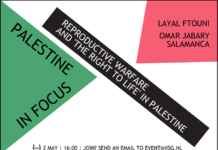Bethan McKernan & Hazem Balousha
The Observer / September 3, 2023
Local archaeologists dedicate their lives to protect priceless artefacts from smugglers, Hamas and Israeli attacks in a land at history’s crossroads
There is considerable debate over the origin of the name Gaza. Some etymologists trace it back to azaz, which means “strong” in Semitic languages; other accounts believe it derives from the Persian word ganj, which means “treasure”.
It’s true that you almost can’t move for ancient treasures in the tiny blockaded strip. Fishers, farmers and construction workers regularly uncover elements of Gaza’s 5,000-year-old past in the course of a day’s work.
In 2013, a priceless life-size bronze statue of Apollo was supposedly found in the Mediterranean by a fisher, who said he was afraid at first he had stumbled across a body in the shallows; last year, a farmer planting trees unearthed an exceptionally beautiful Byzantine mosaic floor of birds and animals, its colours still bright.
Gaza’s image today is that of a place of war and suffering. The forces that make life a misery for the 25.5 mile by 7.5 mile enclave’s population of 2.3 million people also threaten its rich history: valuable items can be seized by Hamas, the militant group that controls the strip, or sold by smugglers to collectors abroad. There is little funding and equipment to adequately excavate or maintain historical sites. Sometimes they are damaged in Israeli offensives.
A clutch of dedicated archaeologists and activists in the strip, however, is determined not to let Gaza’s contributions to civilization be forgotten, working hard to preserve the area’s ancient past despite the many challenges they face.
“No one here has formal training. I’m basically the best we’ve got. There’s a small department attached to the architecture school at the Islamic University, but that’s it,” said Fadel al-Atul, Gaza’s foremost archaeologist.
A lean, tanned man in his 40s with keen eyes, Atul, from the poverty-stricken Shati refugee camp, learned his profession over 20 years by working alongside foreign teams. Their help on archaeological projects has been invaluable since 2007, when Israel and Egypt blockaded the strip after the Hamas takeover.
During the Observer’s visit to a dig in the north of Gaza city, Atul and a dozen young archaeology trainees sweated under tarpaulin shades offering scant relief from the August humidity. A huge Roman cemetery, thought to be about 2,000 years old, was discovered last year during an Egyptian-led building project to replace homes destroyed in the 2021 war between Hamas and Israel.
Excavation work on the site only began in July, after funding was secured from the École Biblique, a French archaeological establishment in Jerusalem, and Première Urgence Internationale, a French NGO. So far, it has unearthed 127 graves, including two rare bronze sarcophagi, and the remains of arrows and other weapons.
“It is lucky for everyone I’m such a nerd,” Atul said. “I get here at 6am every day and I don’t leave until around 7pm. I am excited every day by my job. We can’t take any of this for granted … Gaza has many other urgent problems.”
Gaza, a port city linking the Mediterranean with the trade caravans that traversed the Sinai and Negev deserts, has always been a liminal place at the crossroads of civilizations and cultures. Land, particularly space for building, is at a premium, but there are many more archaeological discoveries waiting to be found.
The Egyptians, Persians, Greeks, Romans, Byzantines, Arabs, Fatimids, Mamluks, crusaders and Ottomans all controlled Gaza at one time or another. In 1799 Napoleon made an ignoble retreat through the enclave after his failed campaign to seize Palestine, and during the first world war, the Ottoman-held city was bombed mercilessly by the Allies; a cemetery here is the resting place of more than 3,000 Commonwealth soldiers.
“Artefacts are always being found by chance,” said Hiam Bitar, director of museums and antiquities at Gaza’s Ministry of Tourism, reaching into her desk for what looked like a ceramic pomegranate about the size of a hand.
“This arrived yesterday,” she said. “We’ve never seen anything like it, but we think it might be an early grenade from the time of Saladin and the crusaders.”
The main obstacles Gaza’s archaeologists face are lack of funding and the blockade, which hampers travel and attempts to import specialist tools, but Bitar and Atul’s work is also made much harder by amateur excavations carried out by would-be antiquities smugglers.
The average daily wage in the strip is 35 shekels (£7.30), and unemployment is currently running at 44%. For many people, the chance to illegally sell objects found on the shoreline after winter storms or dug up while working is too good a financial opportunity to pass up.
All archaeological finds must be reported to the antiquities department, but in Bitam’s office, there is a huge A3 folder containing the details of thousands of confiscated items. Many were found during searches of private collections: the identities of the few collectors in the strip who will pay relatively large amounts of cash for finds brought directly to them are well known.
“We have no idea what we don’t have,” she said. “It’s heartbreaking that our heritage is being stolen.”
Coins and medals are particular favourites for smugglers, since their size makes them easier to transport. They can prove extremely valuable. A spectacular 294 AD gold medallion featuring the Roman emperor Diocletian on one side and the god Jupiter on the other was sold in New York in January to an anonymous bidder for $2.3m (£1.8m) – the highest price ever for an Imperial Roman coin.
Experts in Gaza said they believe it was part of a small trove found in the strip last year, but can’t prove it. The auction listing said the item was of “unknown origin” – as do many pieces from Gaza that illegally end up for sale around the world.
A hoard of rare coins from the time of Alexander the Great found in Gaza in 2017 was smuggled out and made its way to auction houses in the west – this week, Richard Beale, the director of Roma Numismatics, a British company, pleaded guilty in New York to a series of charges concerning unlawful sales, including falsifying the coins’ provenance.
But efforts to keep Gaza’s historical treasures inside the strip and make them publicly available are underway. There are already a handful of small private museums in the territory. Three warehouses operated by the antiquities ministry, with dusty shelves 10 rows high, house thousands of artefacts that could – and should – be on display.
The monastery of Saint Hilarion, or Tel Umm al-Amr, is probably the largest archeological site in Gaza. This early Christian monastery, later expanded as a caravanserai by the Umayyads before being abandoned after an earthquake in the 7th century, was discovered in 1999. Proper excavation and restoration work did not begin until 2017, with the help of the British Council’s cultural protection fund.
The site’s mosaics, crypt and a hammam complex are now protected from the elements with roofing; during The Observer’s visit, excited children peered down from newly installed wooden walkways as they explored a previously inaccessible piece of Gaza’s past.
Atul is hopeful, now that it is properly cared for, that St Hilarion can become Gaza’s first UNESCO-listed world heritage site. Some of its electricity needs are generated by solar panels, and entrance costs one shekel.
“I know we can repeat this in other places in Gaza and make the archaeology sector sustainable,” he said after stopping to give advice to three colleagues cleaning a mosaic. “It’s an honour and a duty.”
Bethan McKernan is Jerusalem correspondent for The Guardian
Hazem Balousha in Gaza












